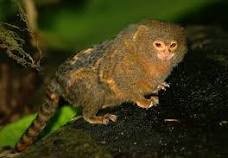
Some really smallest monkeys live in the rainforests of South America called pygmy marmosets. These little creatures are incredible acrobats, swinging around the trees with ease. Even though they’re tiny, they play a big role in the rainforest ecosystem.
.I.Background Information
With their small size and quick movements, pygmy marmosets are nocturnal animals that live in South America’s thick rainforest canopy. These smallest monkeys, who are no bigger than six inches long, are adept at navigating their forest home. They use their keen claws to jump and scamper from tree to tree. They have remarkably flexible foraging habits, consuming mostly tree gum and insects that they extract through nibbling holes in tree bark.
II. Size and Significance
Pygmy marmosets’ small size and quick reflexes Despite their diminutive size, pygmy marmosets have a significant impact on their habitat. Weighing smaller than an apple, they are among the smallest primates on Earth and the smallest monkeys on the globe.. Yet, their size belies their importance in the intricate web of life within the rainforest canopy.
III. Discovery of Two Separate Species
New findings clarify the true diversity of the pygmy marmoset population, as published in the American Journal of Physical Anthropology. It has come to light that these smallest monkeys are found in two different species, not just one homogenous population as was previously thought. Under the direction of biological anthropologist Leila Porter of Northern Illinois, the study used sophisticated genetic analysis and in-depth skull studies to elucidate this intriguing finding.
A. Study Findings Confirming Two Distinct Species
The results of the study clearly show that pygmy marmosets can be identified based on characteristics other than appearance. Fur colour has been shown to be extremely varied and not a reliable indicator of species distinction, despite the fact that it was formerly believed to be a defining trait. Instead, differences in mitochondrial DNA and skull structure have emerged as the primary criteria for species classification.
What Is The Tallest US Bridge [2024]
B. Research Methodology and Sample Acquisition
To arrive at these groundbreaking conclusions, researchers collected samples from 13 sites across South America, meticulously analyzing genetic data and skull morphology. This comprehensive approach provided a holistic view of pygmy marmoset diversity, leading to the identification of distinct species inhabiting different regions of the Amazon basin.
IV. Communication and Social Structure
Communication is key in the bustling world of pygmy marmosets. These tiny primates are well-known for their intricate system of calls, which serve as the glue binding their social fabric. The trill, used during feeding and foraging, signifies unity when the group is close together. Meanwhile, the J-call, a rapid series of notes, serves as a medium-distance contact call.
But it’s the long call that truly highlights the complexity of their communication. Reserved for when the group is spread out or in response to neighboring groups, it echoes through the canopy, a testament to the unity and cohesion of pygmy marmoset society.
V. Taxonomical Reclassification
Pygmy marmoset classification has to be reassessed in order to properly reflect their evolutionary ancestry in light of these groundbreaking discoveries. The pygmy marmosets that were formerly classified as “eastern” and “western” have been reclassified as “northwestern” and “southern” species, which more accurately reflects their geographic distribution and genetic differences..
Proposal for Renaming the Species
The authors of the study support the use of new scientific names for the two species, suggesting “Cebuella niveiventris” and “Cebuella pygmaea” as names. This revised nomenclature improves accuracy and makes future studies and conservation initiatives easier.
VI. Implications and Significance
The finding of two pygmy marmoset species has wider ramifications for our comprehension of primate diversity and ecological processes in the Amazon rainforest than just taxonomic concerns.
A. Insights into Evolutionary Adaptations
The observed differences in skull structure between the two species suggest potential adaptations related to foraging behavior.
Variations in diet and habitat utilization may have driven the divergence of these tiny primates, highlighting the complex interplay between genetics and environment in shaping evolutionary trajectories.
B. Conservation Considerations
The identification of two discrete species emphasizes the significance of focused conservation initiatives to protect their individual habitats. Protecting the biodiversity inside the confines of the Amazon rainforest is becoming more and more important as human activities continue to infringe upon it.
Pygmy marmosets occupy distinct ecological niches, which we can recognize and safeguard to help preserve this priceless environment.
What This Means
Finding out there are two types of pygmy marmosets is a big deal. It tells us more about how life evolves in the rainforest. It also reminds us how important it is to take care of the rainforest and all the creatures living there.
VII. Insights from PBS Nature’s Undercover in the Jungle
We can now see into the sly world of pygmy marmosets like never before, thanks to the revolutionary work of naturalists and the wonders of modern technology. More than fifty remotely operated cameras were set up to film their every move in an Ecuadorian-based episode of PBS Nature’s Undercover in the Jungle.
With unmatched clarity, these cameras saw pygmy marmosets going about their everyday lives in everything from the shadowy depths of the rainforest floor to the towering heights of the canopy. We are able to observe the intricacy and beauty of their existence via their lens, which is proof of the miracles of nature.
VIII. Conclusion
Discovering two different kinds of pygmy marmosets is a big step forward in understanding nature’s mysteries. It helps us learn more about the complicated balance of life in the Amazon jungle, beyond just sorting animals into categories. Let’s stay committed to protecting and taking care of this diverse ecosystem. By studying it closely, we can make sure it stays healthy for our children and grandchildren.

